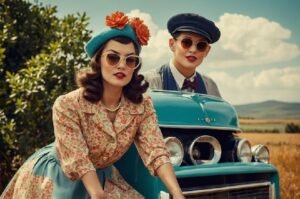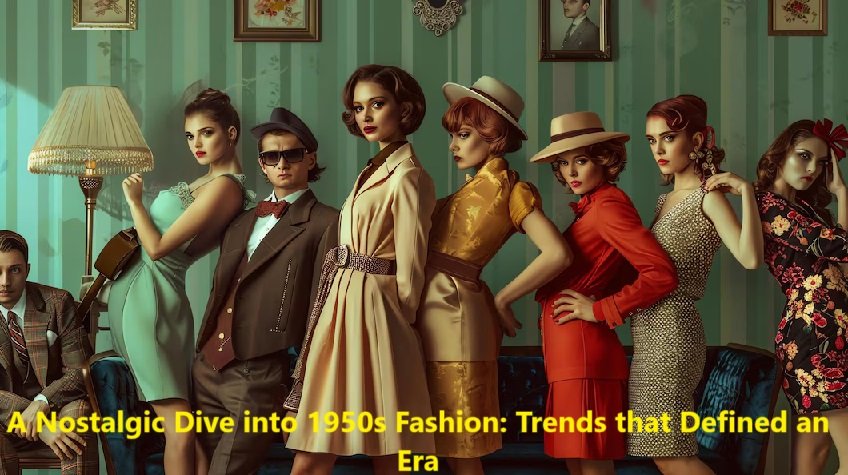1950s Fashion: Iconic Trends and Timeless Style
The 1950s were a time of elegance, femininity, and refinement in the world of fashion. After the hardships of the 1940s, which saw rationing and simplicity due to World War II, the 1950s welcomed a new era of opulence and glamour. Women’s fashion in particular took a dramatic turn, emphasizing curves, grace, and beauty. Meanwhile, men’s fashion also became more streamlined and sophisticated, signaling a decade of renewal and style.
In this article, we’ll explore the key elements of 1950s fashion, from women’s dresses and accessories to men’s sleek suits, as well as the cultural influences that shaped these trends.
The Influence of Christian Dior and the “New Look”
One of the most significant influences on 1950s fashion was Christian Dior’s revolutionary “New Look,” which debuted in 1947. Dior’s designs embraced full skirts, nipped-in waists, and an ultra-feminine silhouette. This new approach was a stark contrast to the utilitarian and modest clothing of the 1940s. The New Look featured:
- Full Circle Skirts: These voluminous skirts defined the waist and flared out, giving women a regal yet playful style.
- Nipped-in Waistlines: Corsets and tailored bodices emphasized the hourglass figure, a key trend throughout the decade.
- Soft Shoulders: Structured, padded shoulders gave way to softer, more natural lines.
Dior’s designs set the stage for what became the ideal 1950s female silhouette: full skirts and a tiny waist, creating a look that was both glamorous and elegant.
Women’s Fashion in the 1950s
While Dior set the tone for high fashion, everyday women embraced a variety of trends that embodied grace and femininity.
1. Poodle Skirts and Swing Dresses
Poodle skirts were a major hit with younger women and teenage girls. These skirts were often made from felt and featured appliqués like poodles, flowers, or other playful designs. Paired with a fitted blouse and saddle shoes, poodle skirts became an iconic look for casual gatherings, school events, and dances.
For more formal occasions, women turned to swing dresses. These dresses, featuring wide skirts and fitted bodices, were perfect for parties, dances, and evening events. The swing dress accentuated the waist while allowing for free movement and dancing, making it both fashionable and functional.
2. Tailored Suits and Pencil Skirts
For a more sophisticated and polished look, women embraced tailored suits and pencil skirts. These outfits were often worn in professional settings or for daytime occasions. Pencil skirts, with their slim, straight cut, were designed to flatter the curves while remaining elegant and understated. They were typically paired with blouses, cardigans, or tailored jackets.
3. Accessories: Gloves, Hats, and Pearls
No 1950s outfit was complete without the right accessories. Gloves, in particular, were a staple for both formal and casual outfits. Women often wore wrist-length or elbow-length gloves, depending on the occasion. Hats were another essential accessory, with pillbox hats and wide-brimmed styles being popular choices.
Pearl necklaces and earrings added a touch of sophistication to every outfit. A simple strand of pearls became synonymous with 1950s elegance, especially when paired with a polished hairstyle like a bouffant or pin curls.
4. Evening Wear
For formal occasions, women turned to glamorous evening gowns made from luxurious fabrics like satin, silk, and taffeta. These dresses often featured strapless or off-the-shoulder designs, and they were paired with matching gloves and stoles for added drama. The A-line silhouette was a popular choice, emphasizing both the waist and the hips.
Men’s Fashion in the 1950s
While women’s fashion emphasized curves and femininity, men’s fashion in the 1950s was sleek and structured. Influences ranged from Hollywood’s leading men to the rise of rebellious youth culture.
1. Suits and Ties
The classic men’s suit was a staple of 1950s fashion, whether for business or formal occasions. These suits typically featured broad shoulders, slim lapels, and single-breasted jackets. Trousers were high-waisted and slim-fitting, creating a clean, tailored look. Dark, neutral colors like charcoal gray, navy, and black were popular, often paired with crisp white shirts and silk ties.
2. Casual Wear: Bowling Shirts and Sweaters
For more casual occasions, men embraced the growing trend of bowling shirts, which were typically short-sleeved with contrasting panels or designs. These shirts often had a retro, sporty vibe and were worn with slacks or jeans.
Cardigan sweaters were another popular choice for casual wear. Often worn over a collared shirt, cardigans gave men a relaxed yet put-together appearance. Leather jackets also gained popularity, particularly among younger men influenced by rebellious movie stars like James Dean and Marlon Brando.
3. Footwear and Accessories
Men’s shoes in the 1950s were typically polished and understated. Oxfords and loafers were common choices for both formal and casual settings. For leisure activities, saddle shoes, similar to those worn by women, became popular.
Accessories were minimal for men, but cufflinks, watches, and hats played a role in completing the look. The fedora, in particular, was a popular hat style for men throughout the decade.
The Rise of Youth Culture: Rock ‘n’ Roll Influence
The 1950s also saw the birth of youth culture, particularly influenced by the rise of rock ‘n’ roll music. Teenagers rejected the formal styles of their parents in favor of more rebellious, casual clothing. Icons like Elvis Presley helped popularize the trend of leather jackets, blue jeans, and slicked-back hair. The “greaser” look became synonymous with rebellion and coolness, characterized by leather jackets, white T-shirts, and denim.

This era also saw the popularity of denim jeans explode among young men and women. Jeans became a symbol of youthful independence and were often paired with T-shirts, flannel shirts, or sweaters for a casual, laid-back look.
Beauty and Hairstyles of the 1950s
Fashion wasn’t just about clothing; hairstyles and makeup also played a crucial role in defining the look of the 1950s.
1. Women’s Hairstyles
The 1950s were known for polished, structured hairstyles. The bouffant, characterized by voluminous hair piled high on the head, became one of the most iconic looks of the decade. Pin curls, victory rolls, and ponytails were also popular hairstyles, often paired with hair accessories like ribbons or headbands.
2. Men’s Hairstyles
Men’s hairstyles were typically sleek and controlled. The pompadour, made famous by Elvis Presley, involved slicking the hair back and upwards to create height at the front. The crew cut and Ivy League haircut were also popular choices, especially among more conservative men.
3. Makeup Trends
Makeup in the 1950s emphasized femininity. Women aimed for a flawless complexion, often achieved with powder and foundation. Bold red lips were a signature look of the decade, paired with winged eyeliner and softly defined brows. Eye shadow in pastel shades was also popular, helping to create a delicate, doll-like appearance.
The Legacy of 1950s Fashion
The impact of 1950s fashion continues to be felt today. Many modern designers draw inspiration from the structured, elegant styles of the decade, and vintage fashion enthusiasts often look to the 1950s for timeless style tips.
From the rise of Dior’s New Look to the rebellious youth culture, the fashion of the 1950s remains an iconic period in history. Its emphasis on femininity, glamour, and polished presentation set the stage for many of the fashion trends that would follow in the decades to come.
In today’s fashion world, elements of 1950s style—such as high-waisted skirts, fitted dresses, and bold accessories—continue to make appearances on runways and in everyday outfits, proving that the charm of this era is truly timeless.
Read More: Acubi Fashion
